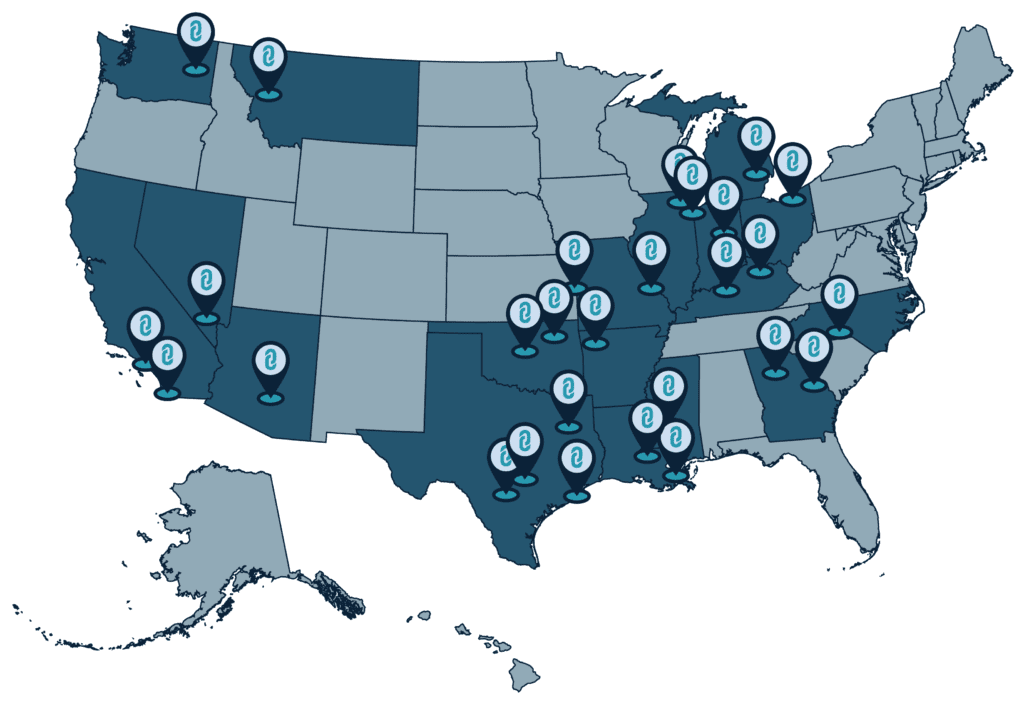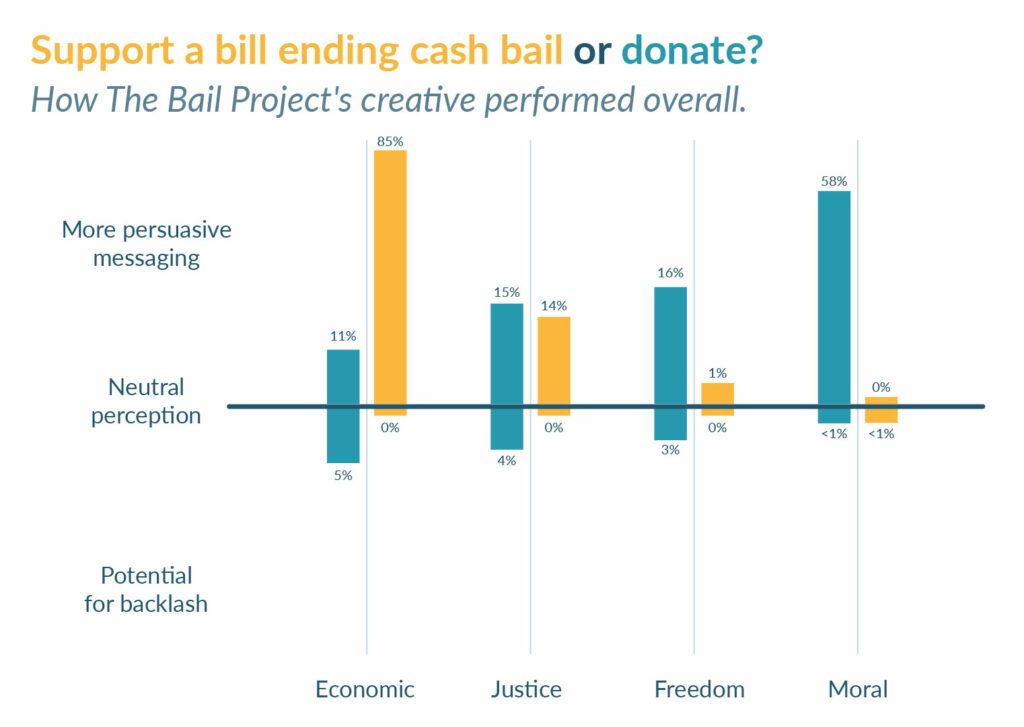Download the Whitepaper
The Bail Project, a nonprofit that provides no-cost bail assistance and pretrial support services for low-income individuals, partnered with Civis Analytics to determine the persuasiveness of its bail reform messages. Civis’s Creative Focus online messaging tool determined that economic-themed messaging was most successful at increasing support for legislation eliminating cash bail, while messages spotlighting the moral toll of the existing cash bail system proved most effective for driving donations to the cause, suggesting The Bail Project should disambiguate these messages for maximum impact.
The United States incarcerates more people per capita than any other developed nation, but 74 percent of the individuals occupying American jails at any given time have not been convicted of a crime. They are disproportionately from Black communities, and they are behind bars for no other reason than that they cannot afford to make bail.
There are two choices facing people trapped in this legal limbo: forfeit your right to trial and plead guilty in exchange for time served or a reduced sentence, or languish in a jail cell in the hopes they’ll ultimately be proven innocent in a court of law. Most accept the plea bargain, because the financial, emotional, and familial costs of spending months in pretrial detention are too great to endure. Pleading guilty comes with severe costs of its own, however — namely, a permanent criminal record, and the lifelong consequences that follow.
The Bail Project believes there’s a better way. The national nonprofit provides no-cost bail assistance and pretrial support services for thousands of low-income individuals every year, while at the same time campaigning to eliminate cash bail and racial disparities in the pretrial process, and demonstrate a community-based alternative to incarceration.
Since launching in early 2018 with the support of TED’s Audacious Project, The Bail Project’s national revolving bail fund has paid in excess of $45 million in free bail assistance in more than two dozen U.S. jurisdictions (see map below), liberating some 17,000 people to resume their everyday lives while they await trial. And because bail is returned at the conclusion of each case, donor funds can be immediately reused to assist other candidates.

The results speak for themselves: clients return for more than 90 percent of their court dates, even without a financial obligation to The Bail Project or to the courts, says Camilo Ramirez, the organization’s director of communications.
“We believe that ending cash bail is one of the defining civil rights and racial justice issues of our day. We’re working not only to bring tens of thousands of people home to their families, but to restore the presumption of innocence and make the case for ending cash bail indisputable,” Ramirez says. “Our data is clear: You don’t need cash bail as an incentive for people to come back to court: people come back simply because they need to come back. The presumption of innocence is one of the cornerstones of our democracy. It shouldn’t be up for sale. We’re using data and elevating the stories of our clients to make this argument, both in the court of public opinion and at the legislative level.”
The Bail Project pleads its case for criminal justice reform across a range of channels and contexts, including written opinion pieces, social media posts, educational videos, and news media interviews. While its core messages and talking points certainly seem persuasive based on the organization’s fundraising success, executives didn’t want to leave anything to chance.
“Data and human stories are a powerful combination, but it’s how you frame an issue that can make all the difference,” Ramirez says. “We need to fill information gaps and challenge the dominant narrative about incarceration with facts, but we also need to appeal to people’s values, make them care, and bring them into the mission. So we test and learn. Which messaging frames are more effective among audiences who might be on the fence about this issue? Do any messages have an unintended backlash effect? Ultimately, we want to take an approach that was informed by evidence, not just anecdotes or stereotypes.”
The Bail Project partnered with Civis Analytics to gather that evidence, testing four key reform messages highlighting cash bail’s disproportionate impact on people of color: the individual messages focused on the presumption of innocence, mass incarceration, economics, and the moral cost of our existing pretrial system, respectively. Using Civis’s Creative Focus online message testing tool, which utilizes randomized control trial experiments to quantify an advertisement’s persuasiveness and potential for negative impact among different audience subgroups, The Bail Project was able to scientifically validate that its call for change was not only resonating loud and clear, but was even carrying across political lines.
At the same time, however, Creative Focus determined that economic-themed messaging was most effective at boosting support for legislation ending cash bail: between food, healthcare, and security expenditures, American taxpayers shell out roughly $14 billion annually to incarcerate people pretrial, and when taking into account the overall collateral impact on justice systems, communities, and individuals, the price of pretrial detention climbs to an estimated $140 billion each year. On the other hand, messages emphasizing the moral toll proved most powerful for driving donations to the cause, suggesting The Bail Project should disambiguate the two messages to ensure maximum influence (see charts below).

“A key insight from the message test was seeing how, across the ideological spectrum, there’s a good base level of support for bail reform even before you apply the message,” Ramirez says. “About half of respondents who identified as conservative voiced their support for ending cash bail. Then once we applied the different messages, we saw that support increase to varying degrees. We’re doing work in liberal and conservative markets, and testing very much informs how we frame our arguments for different audiences.”
Understanding how to speak directly and convincingly to different audiences is especially critical given that bail reform is a battle The Bail Project must wage on a state-by-state basis.
“Bail systems are state-based, and while federal reform could create incentives to change local bail policies, ultimately, change is up to the states,” Ramirez explains. “That is why The Bail Project has created a portfolio of sites across a wide range of states, so we can make our argument and demonstrate our model in a variety of contexts. To support that strategy, a key goal is to make this issue somewhat apolitical — not an issue of Democrat versus Republican, but an issue that costs us all. Better justice is better for everyone.”
“We hope that becomes the trend — that the issue of bail, rather than one that politicians can use to divide, instead creates a starting point for consensus on how to begin reforming the criminal legal system,” Ramirez says. “At the end of the day, ending cash bail is just the beginning. For far too long, we have used jails and courts to respond to issues of poverty, inequality, and public health. Ending cash bail could create the opening for investing in new approaches that actually address the root causes of crime and lift people out of poverty, rather than continue pushing millions into the revolving door of mass incarceration.”
In the meantime, The Bail Project is ramping up a new campaign dubbed Bail Out the South, which will focus on extending the nonprofit’s services to thousands of Black and low-income communities across the southern U.S., home to the nation’s highest rates of pretrial jail incarceration. Nearly half of all Black Americans in jail are housed in southern jails, according to Bail Project data; moreover, research from the Prison Policy Initiative shows judges are more likely to set higher bail amounts for Black defendants, who are in turn less likely to be able to pay for their release.
The Bail Project is also working with the Ad Council on a PSA campaign to raise awareness about the harms of the cash bail system, producing a series of spots informed by the results of its earlier Creative Focus message tests. The Bail Project will again leverage Creative Focus to test these new PSAs and gauge the effectiveness of its messages and messengers before rolling out the ads to a wide audience.
“I find that a lot of organizations frame issues in terms of how they want to position themselves politically, or how they want to be perceived. It’s also a question of brand: ‘If we use this language, if we talk about it this way, it puts us on this part of the spectrum.’ We didn’t want to fall into that trap,” Ramirez says. “We know who we are, we know what our values are, and we also know that we have to persuade people — and you don’t convince people by hitting them over the head with the way you want to frame an issue or how you want to be seen. We’re testing ‘Are we talking about this in the most effective way possible?’ while still staying true to our values. This insight allows us to be self-critical and be reflective, and ask ourselves ‘Is this really working?’ For the most part, it does.”
For more information on how Creative Focus message testing can help your organization communicate in the most effective way possible, email hello@civisanalytics.com.